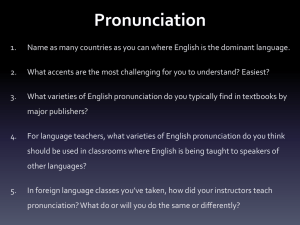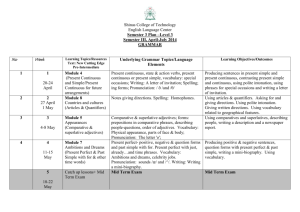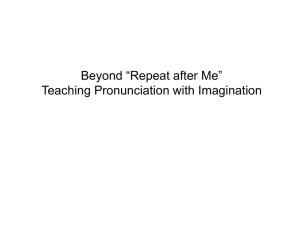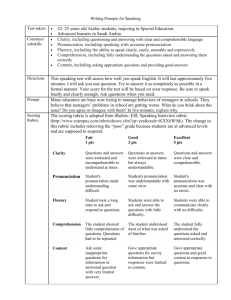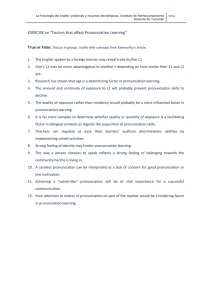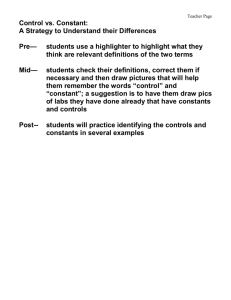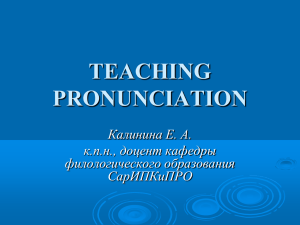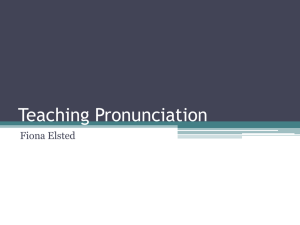Unit 6 Teaching Pronunciation
advertisement
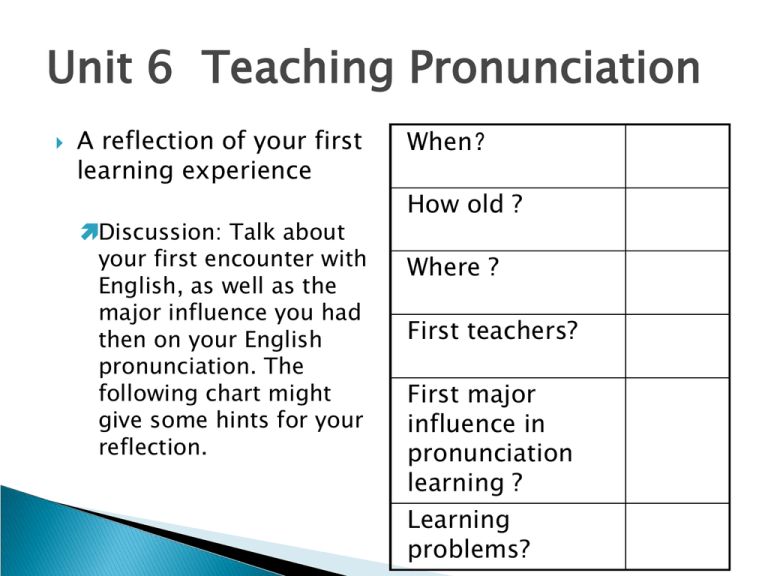
Unit 6 Teaching Pronunciation A reflection of your first learning experience Discussion: Talk about your first encounter with English, as well as the major influence you had then on your English pronunciation. The following chart might give some hints for your reflection. When? How old ? Where ? First teachers? First major influence in pronunciation learning ? Learning problems? 1. The role of pronunciation 1.1 Some disputes Pronunciation will take care of itself as students develop overall language ability. Failure in pronunciation is a great hindrance to language learning? 1.2 Your understanding 2015/4/12 2 Students need to be able to read phonetic transcripts of words. Students need to be able to write phonetic transcripts for words. Students need to know phonetics in order to learn English. Poor pronunciation may cause problems for the learning of other skills. Adult learners need to focus on pronunciation, but young learners don’t . Both consistency and accuracy in pronunciation are very important. Stress and intonation are not important for beginning learners. Students should learn Received Pronunciation. Stress mispronunciation is sometimes as important as grammar. Bad intonation can lead to important misunderstandings 2015/4/12 3 2. The goal of teaching pronunciation What is a sensible goal, to be native-like or intelligible? The basic and realistic goal: Consistency Intelligibility Communicative efficiency 3. Aspects of pronunciation teaching Sounds Combination of sounds Word stress Sentence stress Linking Strong form and weak form Rhythm Intonation 4. Practices of teaching English pronunciation 4.1 Practising sounds Focusing on a sound Imagine that you want to focus on a sound which your students are having difficulty with. How will you do it? Which of the following steps are necessary? In what order would you teach and practice the sound? Tick the steps that you think are necessary and write the order numbers in the brackets. ( ) __ Get the students to repeat the sound in chorus. ( ) __ Explain how to make the sound. ( ) __ Contrast it with other sounds. ( ) __ Write words on the blackboard. ( ) __ Get individual students to repeat the sound. ( ) __ Say the sound in a word. ( ) __ Say the sound alone. ( ) __ Say the sound in meaningful context. 2015/4/12 7 Perception practice 1. Using minimal pairs 2. Which order? 3. Same or different? 4. Odd one out. 5.completion. Do Task 5. 2015/4/12 8 Production practice 1. Listen and repeat 2. Fill in the blanks. 3. Make up sentences 4 . Use meaningful context. 5. Use pictures 6. Use tongue twisters 2015/4/12 9 4.2 Practicing stress and intonation Stress 1. use gestures 2. use the voice 3. use the blackboard Intonation -- Where's your ↘ lab book? -- I ↘ lost it. -- Did he bring his ↗money? -- No, he for ↘ got it. -- Do you know ↗German? -- I can ↘↗read it. 2015/4/12 10 5. Further suggestions: p101 Use individual, pair, group and whole class work to create a pleasant, relaxed, and dynamic classroom. Use hands and arms to conduct choral pronunciation practice. Move around the classroom when doing choral practice. Vary the criteria of “good” in pronunciation practice to give students confidence. Bring interests and variety to the practice of pronunciation. For example, asking students to practise an expression in different tones to show anger, happiness, surprises, sadness or excitement, etc. The main criteria for good pronunciation are consistency, intelligibility, and communicative efficiency. Do not rely on explanations. Make full use of demonstrations. Try to use visual aids.


